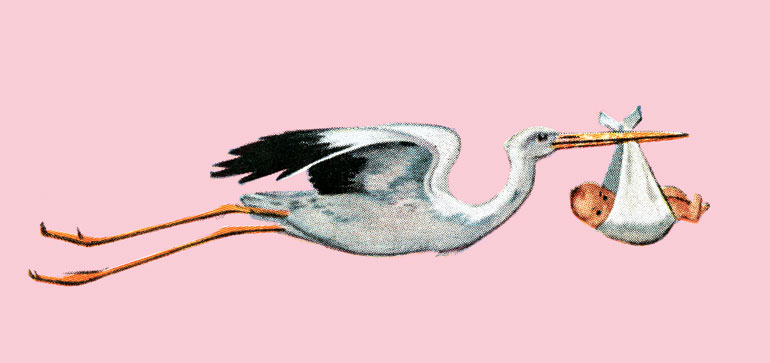My daughter’s curiosity about pregnancy reached a fever pitch when she was five years old. With no regard for place or time, she hit me with question after question:
How do babies come out? How does a woman get a baby in her tummy? I gave her a little information. She begged for more: What does the egg look like?
I felt embarrassed that an obsession (truth be told) with baby-making had hit CeCe before her friends were showing any curiosity, and turned to my friend, Ann, an adoptive mother of four. Talk candidly about pregnancy and birth with my daughter, just as we’d talked openly about adoption from an early age, she counseled.
Set the birds and bees free and they’ll lose some of their allure. “My kids were so grossed out that their interest waned a bit,” she said, laughing.
But a recent trip to the vet to have our dog neutered set off another round of questions from CeCe, now seven. Seeing my golden opportunity, I took a couple of deep breaths, and, this time, my words flowed more assuredly: The testicles make sperm. Sperm and an egg have to combine in order for a baby to be made…
While my daughter’s questions have tapered for the moment, I’m ready for the next part of the discussion. Read on for some advice from AF‘s panel of experts and you will be, too. —DEBORAH POPE
Your next-door neighbor is pregnant — and your preschooler is fascinated with the idea that there is a baby in her tummy. He’s been asking what it was like when he was in your tummy.
JONI MANTELL: All children this age want nothing more than to be as close to their mother as possible. For your child, this is not an adoption question but a very age-appropriate expression of his love for you. Acknowledge his feelings and, because he’s asked directly, explain honestly that he grew in another woman’s tummy and then joined your family.
He’ll be sad; this sadness will not be about his birth mother but about his wish to have grown inside the mother he knows and loves. You can say, “I know you feel sad. Sometimes I wish you had grown in my tummy, too, but I feel as close to you as if you had. I love you.”
Your three-year-old’s favorite game is pretending that she’s being born from your tummy. She jumps out from under your dress, saying, “I’m here!” at which you exclaim, “Oh, what a beautiful baby!” Sometimes, though, you wonder if it’s confusing or strange to play this game.
MARY ANN CURRAN: Most children don’t really grasp the fact of another mother until they reach age five to seven, so go right ahead and play the game. You can also introduce an adoption game, in which you pretend to travel to meet her and then enact your joy at this first meeting. Multiple games will ensure that the fact of her adoption and her birth will be parts of her story until she’s ready to sort it all out.
JM: Children this age are making sense of being separate from the mom they adore. Just as we don’t tell children they are not doctors or cowboys when they pretend, there’s no reason for an adopted child to not play “being born” with you, their mother. Their understanding of the adoption part of the story will come soon enough.
You’ve told your kindergartener about her adoption, and she seems to understand that she was born to another woman. It seems too early to mention how babies are conceived, so you haven’t talked about her birth father yet.
JM: Until kids understand birth and reproduction, it is confusing to think about having two sets of parents. You can simply add “and birth father” to your child’s adoption story, to text in a book on the birds and bees, or to any comment you make about her birth mother. “When your birth mother and birth father were expecting you,” you might say, “they knew they could not take care of a baby, and they wanted you to have a forever family.” If the birth father isn’t mentioned, a child may think that her adoptive father is her birth father. This makes sense, especially if the adoptive father is the only man in her world. It also suits her fantasy, since he is the father she knows and loves.
RONNY DIAMOND: Just as children grow into an understanding of adoption, so too do they grow into an understanding of conception, birth, and reproduction. You may want to start by talking about the fact that it takes a woman and a man to make a baby. Emphasize that everyone who has ever been born came from both a mother and a father. Then, if you still have her attention, explain that “babies grow in a special place inside the woman, called a womb. Some babies always live with the people who give birth to them, and others, like you, go to new parents, and that’s called adoption.” You can remind her that she has a birth mother and mention that she also has a birth father.
You adopted your six-year-old through an open adoption, and she knows you were at the hospital for her birth. Lately, she’s been asking a lot of questions about the day she was born.
RD: This is a great opportunity for you to tell her what happened before you brought her home. You can say, “You were growing inside your birth mother’s womb, and when you were ready to be born, you let your birth mother know, maybe by kicking the inside of her womb. That meant it was time for all of us to get to the hospital.” Don’t leave anything out — tell her who called you to say ‘come now,’ how you got to the hospital, who else was there, and any amusing mishaps that happened as you rushed to get there.
Then you can say, “When you were ready to be born, you came out of a part of a woman’s body called the vagina.” Let her know that her birth was a special moment for everyone.
JM: Children often want to know what happened from the time they were with their birth mother until the time they came to their adoptive parents. They may be anxious about this “in-between time” and may wonder if they were alone and abandoned, or safe and cared for. Reassure your daughter by saying something like, “We were in the delivery room. We watched you being born and we held you as soon as the doctor delivered you.” Emphasize how happy you were at her arrival. Share anything her birth mother said about her, as well: “Your birth mother held you and said you were beautiful.”
Your seventh-grader knows that his birth mother was 17 when she had him. You want to discourage him from being sexually active as a teen.
JM: If your son’s birth mother placed him for adoption because she wanted him to have a traditional, two-parent family, tell him that. Explain that this is why you — and his birth mother — believe postponing sex (and avoiding teen pregnancy) is best.
You’re worried that your daughter, who’s a junior in high school, thinks that it’s her destiny to get pregnant because that’s what her teenaged birth mother did. You want her to understand that this doesn’t have to be so, but how?
RD: As parents, the most important thing we give our children is a sense of values, ethics, morals, and principles by which to live their lives. Adoptive parents tell their children all the time that being adopted isn’t better or worse than being born into your family, it’s just different.
The fact that you want your daughter to wait until she is more mature, or married, before becoming sexually active or having a baby is about your values and choices for your family. It’s not about her birth mother. Be sure to make this clear in your talks, and never disparage her birth mother or suggest that she’s a bad person for making different choices.
MC: Now’s the time to revisit her adoption story. You can reopen the topic by saying, “You’re older now, and I want you to know the facts of your adoption in a grown-up way.” Say that teen sex can lead to difficult choices. Point out that her birth parents made a responsible choice to place her for adoption, but that it was a very hard choice. You would hate to see her have to make such a tough decision.


